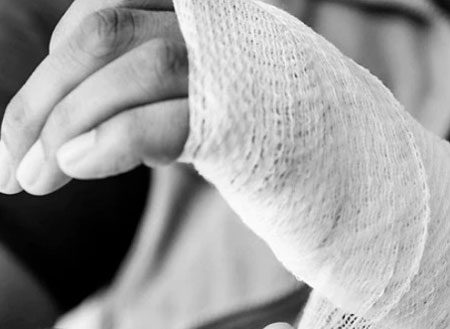Wounds-a common occurrence in our clinic. Sometimes they walk in to utilize our Ortho ASAP clinic for acute injuries. Sometimes they develop over time due to a myriad of pathologies. Shoot, sometimes we create them when we take a patient into the operating room for surgery. Wounds can be persnickety, which naturally means that the treatment thereof can be persnickety as well. Dry dressing changes, wet-to-dry dressings, antibiotic dressings, waterproof dressings, staples, stitches, and skin glue...let me tell you, the wound care section of our supply room has more products that even I know what to do with sometimes.
The main concern anytime an open wound is present is infection. Our first goal is to prevent any type of infection from developing, which is why if you have ever had a cut (or laceration) stitched back together in the Emergency Room, they washed out the area before sewing you up and sending you home with a prescription for prophylactic antibiotics. If you had surgery, you were given intra-operative antibiotics through an IV.
Once infection precautions have been dutifully handled, the next step is to dress the wound. Different kinds of wounds have different needs for dressings. Larger surgical wounds are often covered in some type of water-proof bandaging for at least the initial post-operative period because water in a fresh incision is a recipe for disaster. Our goal is to keep the incisional area clean and dry to allow it the best chance at healing. We have a few different types of dressings that create a tight seal around the incisional area so you can shower without having to protect your incision. Once you are outside that initial (often seven day) period, we usually recommend daily dry dressing changes to include sterile gauze secured by paper tape. The gauze will absorb any lingering drainage from the wound, and the paper tape is gentle on the skin. Staples or stitches are then removed 10-14 days after application, which is a simple procedure that typically causes minimal discomfort. Patients often ask when they can bathe with an incision. We ask that patients wait until the incision is completely healed-cinched together, free of scabs and drainage, and with no gapping if stress is applied.
Patients are often tempted to massage some kind of topical cream in and around the incision in the hopes of healing it more quickly and minimizing the eventual scarring. It is very important to NOT apply anything gooey to the area because keeping that incision moist will not allow the layers of skin to cinch together and heal properly. Also, bacteria from your hands or whatever container holds your preferred goo could get massaged right into your incision.
It is only when complications arise that more complicated wound care must be utilized. Sometimes wounds don’t heal from the inside out and a method of wet-to-dry dressings is necessary. Other times, excessive drainage is present and a wound vacuum is necessary to contain the drainage and help suction and seal the wound together to prevent further drainage. Diabetics and smokers are at an increased risk of sustaining wound complications and should take extra care to follow wound care instructions. If all goes well, our expert board-certified surgeons will have your skin all closed up and healing well in no time. Just be sure to cover that scar in plenty of sunblock the next time you hit the beach!

